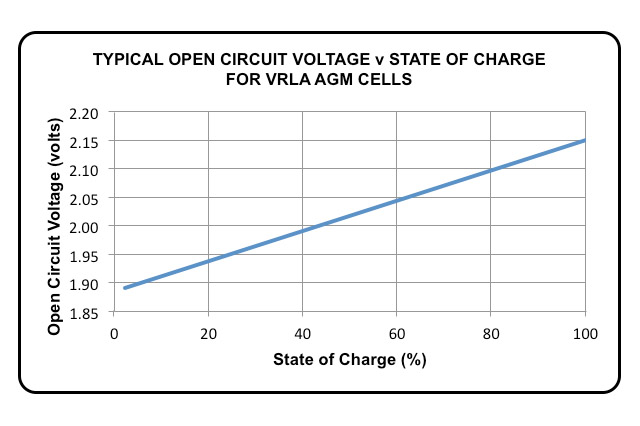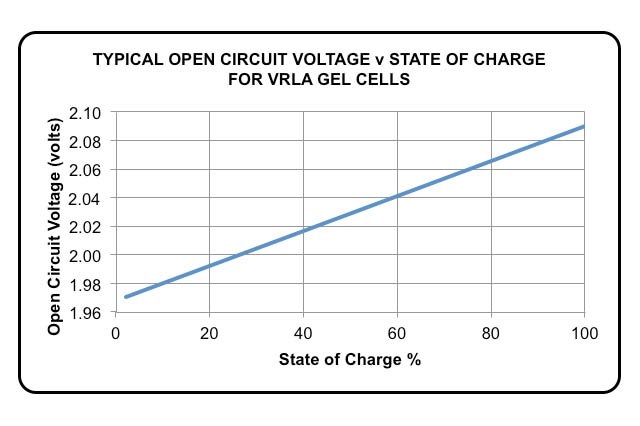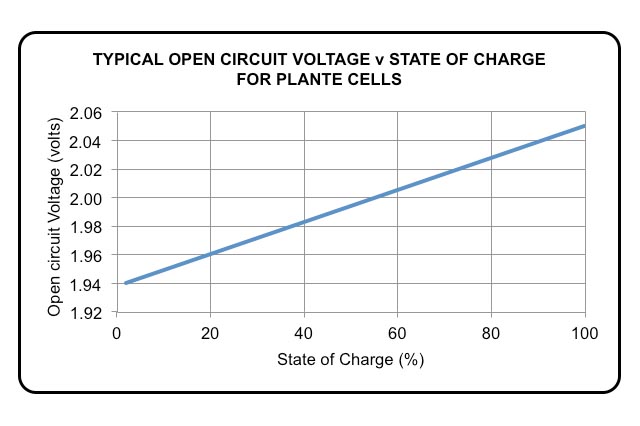Battery Open Circuit Voltage Characteristics.
The open circuit voltage of lead acid cells can give us useful information providing it is used correctly.
This article shows the relationship between the open circuit voltage and state of charge of lead-acid cells and how to interpret the values. The values are always considered as that of a single cell and monobloc voltages must be averaged according to the number of cells. This method was developed primarily for VRLA cells where the specific gravity cannot be measured. Measurement of the specific gravity will give a good indication of the state of charge. For measurement of either specific gravity or open circuit voltage, the fully charged and fully discharged specific gravity must be known. Used correctly, the method described in this article will give reasonable results to the state of charge of cells on open circuit.
Some specific rules apply when using this method to determine the state of charge as follows: -
a) The cell or monobloc must have been on open circuit for at least 12 hours and preferably more than 24 hours.
b) The cell or monobloc temperature should be between +10°C and +30°C for best accuracy but any cell or monobloc temperature between 0°C and +40°C will give reasonable results.
c) The measuring instrument must be accurate to within ±1% and capable or recording voltages from 0.5V to 2.2V to at least 2 decimal places.
The open circuit voltage of vented cells such as Planté, tubular and flat plate pasted types can be used in a similar way to the method used for VRLA AGM and VRLA GEL cells. However, when the electrolyte specific gravity can be measured, this will give a more accurate result. Never the less, open circuit voltage measurement can provide sufficient accuracy in most cases and the ease of measurement means the process is quick. A graph below gives the typical parameters. Similar graphs for VRLA AGM an VRLA GEL products may also be found below.
It can be seen that the relationship between the open circuit voltage and state of charge follows a straight line. This, in the most port is correct within the limits required for lead-acid batteries. The mathematical equation is: -
Open Circuit Voltage = Specific Gravity + 0.84.
Example: OCV = 1.15s.g. + 0.84 constant = 1.99V. Note: this is close to 2V which is why the measuring instrument needs to be reasonably accurate.
If we know the fully charged and fully discharged specific gravity, we can draw the straight line graph.
Typically for VRLA AGM cells, the fully charged specific gravity is 1.310s.g. at 20°C and the fully discharged value is 1.10s.g. These reflect an open circuit voltage of typically 2.15V when fully charge and 1.94V when fully discharged. It should be noted that even when the cell is fully discharged the voltage will be close to 2V again illustrating that the measurement accuracy is important. When it comes to monobloc voltages, the total voltage needs to be divided by the number of cells to find an average.
We can make use of this characteristic in several ways but the most practical is to establish the state of charge of cells that have been in storage for some time. Typically, for VRLA AGM cells, manufacturers will recommend a freshening charge after 6 months in storage. This will be shorter for higher temperatures and longer for lower temperatures. For example, 6 months at 20°C will typically become 3 months when the storage temperature is 30°C. Although the storage time may be extended if the temperature is lower, this is not recommended beyond the manufacturer’s recommendations because irreversible sulphate may result and special charging techniques may be required to fully recover the product. This technique of measuring the open circuit voltage can be used to identify low voltage cells prior to installation. For monoblocs this is more difficult but can be used to identify low cells within a monobloc that may be the result of a soft short resulting from a manufacturing fault.
For example if a battery contains 55 VRLA AGM cells it would be expected that the voltages will all be reasonably the same such as within 0.02V of each other; e.g. 2.10Vpc to 2.12Vpc. If any cell is outside the 0.02V limit, this should be questioned. Where soft shorts are concerned, the voltage differential is likely to be more like 0.05V for cells that have been on open circuit for some time.
Although the principal can be used for multi cell monoblocs, it is not as easy to identify rouge product. Even soft shorts which may result in one cell having a voltage 0.05V lower than the average are not very easy to identify. For example, if we consider a 12V 6 cell monobloc having a voltage of 12.70V this could be made up of 6 cells each 2.117V or 5 cells each 2.12V and one cell of 2.10V (total 2.12V x 5 = 10.6V + 2.10V = 12.7V). Under normal circumstances this would not be rejected and the rouge bloc may be missed.
For monoblocs, the voltage deviation from bloc to be needs to be wider otherwise good product may be rejected. For 6V 3 cell blocs a limit of 0.1V of each other is reasonable to question the unit. For 12V 6 cell blocs a variation of 0.15V is reasonable. These limits may seem close but in the context of monoblocs, all the cells would have been stored in exactly the same conditions and this cannot be said for individual cells. In fact, individual cells may have come from different batches and it is possible that a group of cells may be different from another group of cells. The technique must be used with some knowledge and expertise and if in doubt, it would always be wise to contact the supplier or manufacturer.
Looking in isolation at bloc voltages may not show up any rouge units but if a battery comprised 33 blocs and 32 are 12.70V and one bloc is 12.60V, a question has to be raised. The installation process could be completed but a note should be made and if the bloc voltage does not recover on float charge after 6 months and perhaps deteriorates or the differential between other blocs increases, then there is a reasonable case for exchanging the rouge bloc.
A final comment about open circuit voltages is to mention that for NiCd cells you can not apply this principal because the s.g. of the electrolyte does not change with state of charge. It shall also be noted that the NiCd open circuit voltage is not stable and typically varies between 1.2V and 1.3V.


